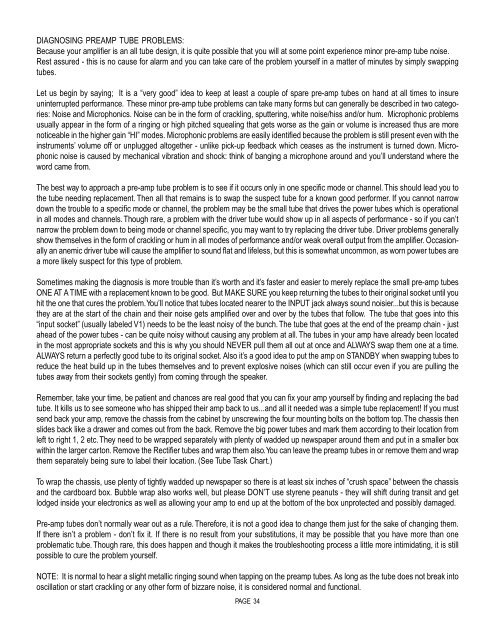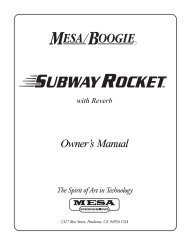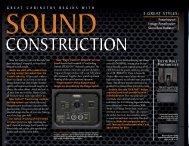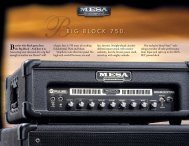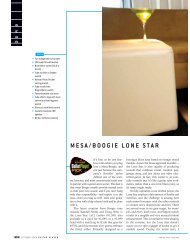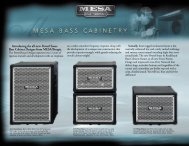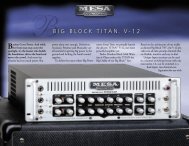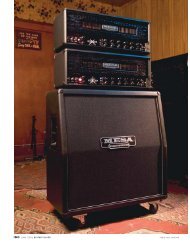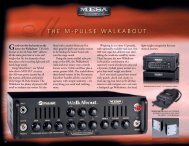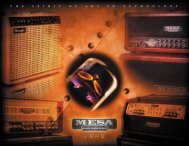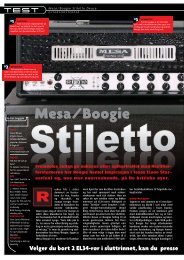Road King Manual - Mesa Boogie
Road King Manual - Mesa Boogie
Road King Manual - Mesa Boogie
- No tags were found...
Create successful ePaper yourself
Turn your PDF publications into a flip-book with our unique Google optimized e-Paper software.
DIAGNOSING PREAMP TUBE PROBLEMS:Because your amplifier is an all tube design, it is quite possible that you will at some point experience minor pre-amp tube noise.Rest assured - this is no cause for alarm and you can take care of the problem yourself in a matter of minutes by simply swappingtubes.Let us begin by saying; It is a “very good” idea to keep at least a couple of spare pre-amp tubes on hand at all times to insureuninterrupted performance. These minor pre-amp tube problems can take many forms but can generally be described in two categories:Noise and Microphonics. Noise can be in the form of crackling, sputtering, white noise/hiss and/or hum. Microphonic problemsusually appear in the form of a ringing or high pitched squealing that gets worse as the gain or volume is increased thus are morenoticeable in the higher gain “HI” modes. Microphonic problems are easily identified because the problem is still present even with theinstruments’ volume off or unplugged altogether - unlike pick-up feedback which ceases as the instrument is turned down. Microphonicnoise is caused by mechanical vibration and shock: think of banging a microphone around and you’ll understand where theword came from.The best way to approach a pre-amp tube problem is to see if it occurs only in one specific mode or channel. This should lead you tothe tube needing replacement. Then all that remains is to swap the suspect tube for a known good performer. If you cannot narrowdown the trouble to a specific mode or channel, the problem may be the small tube that drives the power tubes which is operationalin all modes and channels. Though rare, a problem with the driver tube would show up in all aspects of performance - so if you can’tnarrow the problem down to being mode or channel specific, you may want to try replacing the driver tube. Driver problems generallyshow themselves in the form of crackling or hum in all modes of performance and/or weak overall output from the amplifier. Occasionallyan anemic driver tube will cause the amplifier to sound flat and lifeless, but this is somewhat uncommon, as worn power tubes area more likely suspect for this type of problem.Sometimes making the diagnosis is more trouble than it’s worth and it’s faster and easier to merely replace the small pre-amp tubesONE AT A TIME with a replacement known to be good. But MAKE SURE you keep returning the tubes to their original socket until youhit the one that cures the problem. You’ll notice that tubes located nearer to the INPUT jack always sound noisier...but this is becausethey are at the start of the chain and their noise gets amplified over and over by the tubes that follow. The tube that goes into this“input socket” (usually labeled V1) needs to be the least noisy of the bunch. The tube that goes at the end of the preamp chain - justahead of the power tubes - can be quite noisy without causing any problem at all. The tubes in your amp have already been locatedin the most appropriate sockets and this is why you should NEVER pull them all out at once and ALWAYS swap them one at a time.ALWAYS return a perfectly good tube to its original socket. Also it’s a good idea to put the amp on STANDBY when swapping tubes toreduce the heat build up in the tubes themselves and to prevent explosive noises (which can still occur even if you are pulling thetubes away from their sockets gently) from coming through the speaker.Remember, take your time, be patient and chances are real good that you can fix your amp yourself by finding and replacing the badtube. It kills us to see someone who has shipped their amp back to us...and all it needed was a simple tube replacement! If you mustsend back your amp, remove the chassis from the cabinet by unscrewing the four mounting bolts on the bottom top. The chassis thenslides back like a drawer and comes out from the back. Remove the big power tubes and mark them according to their location fromleft to right 1, 2 etc. They need to be wrapped separately with plenty of wadded up newspaper around them and put in a smaller boxwithin the larger carton. Remove the Rectifier tubes and wrap them also. You can leave the preamp tubes in or remove them and wrapthem separately being sure to label their location. (See Tube Task Chart.)To wrap the chassis, use plenty of tightly wadded up newspaper so there is at least six inches of “crush space” between the chassisand the cardboard box. Bubble wrap also works well, but please DON’T use styrene peanuts - they will shift during transit and getlodged inside your electronics as well as allowing your amp to end up at the bottom of the box unprotected and possibly damaged.Pre-amp tubes don’t normally wear out as a rule. Therefore, it is not a good idea to change them just for the sake of changing them.If there isn’t a problem - don’t fix it. If there is no result from your substitutions, it may be possible that you have more than oneproblematic tube. Though rare, this does happen and though it makes the troubleshooting process a little more intimidating, it is stillpossible to cure the problem yourself.NOTE: It is normal to hear a slight metallic ringing sound when tapping on the preamp tubes. As long as the tube does not break intooscillation or start crackling or any other form of bizzare noise, it is considered normal and functional.PAGE 34


